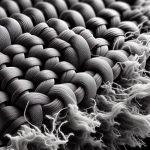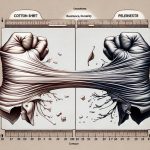Yes, I've learned that Tencel is indeed stronger than cotton. It turns out that Tencel's fiber structure gives it a higher tensile strength, which means it can withstand more pulling force before breaking. Also, it seems to handle wear and tear much better, maintaining its integrity and look over time. Since Tencel's production enhances its molecular strength, it's not just about comfort; it's about lasting quality too. Interestingly, the methods used in making Tencel also contribute to its durability. There's more to uncover on how this impacts the use and sustainability of Tencel compared to cotton.
Table of Contents
Key Takeaways
- Tencel exhibits higher tensile strength than cotton, enhancing its overall strength.
- Durability tests show Tencel outperforms cotton in resisting wear and tear.
- Tencel maintains its shape and integrity better than cotton under stress.
- The molecular structure of Tencel, enhanced during production, contributes to its superior strength.
- Tencel's resistance to pilling ensures long-term durability compared to cotton.
Understanding Tencel
What exactly is Tencel, and why is it considered stronger than cotton? Well, let's break it down.
Tencel is a type of fiber that's gaining a lot of buzz for its strength and durability. Its secret lies in its fiber structure and the production process. Unlike cotton, Tencel fibers are engineered to be stronger and more resilient. This means they've a higher tensile strength, which is just a fancy way of saying they can handle a lot of stretching and pulling without breaking.
The durability of Tencel also stands out. It's designed to resist wear and tear, making it ideal for everyday use and items that need to last. Because of this, Tencel is often a go-to for high-quality textiles that are meant to withstand a lot of use.
This is all possible due to how Tencel is made. The production process enhances the molecular structure of the fibers, making them not only stronger but also sturdier than those in cotton. So, when you're looking for something that's built to last, Tencel's your guy. It's all about giving you more bang for your buck with a product that holds up over time.
Exploring Cotton
Let's dive into the world of cotton, a natural fiber cherished for its softness and durability. When we talk about cotton, we're not just talking about any fabric; we're discussing a versatile material that feels like a hug every time you slip into your sheets. What makes cotton so special? Well, let me break it down for you:
- Varieties: There are several types of cotton, such as American Upland, Pima, and Egyptian. Each type gives your fabric a different feel and texture, affecting how your sheets or clothing feels against your skin.
- Thread Count: Typically, cotton sheets boast a thread count ranging from 200 to 400. This count is a big deal because it influences the smoothness and quality of your sheets. Higher thread counts mean tighter weave, which often translates to more durability and softness.
- Breathability: Cotton's breathability is unmatched, making it ideal for bedding. It allows air to circulate, which helps regulate your body temperature, keeping you cool in summer and cozy in winter.
Cotton's staple length also plays a crucial role in its feel and quality. Longer fibers mean smoother, stronger threads that contribute to both the fabric's feel and durability. Whether it's Tencel or cotton, each has its unique advantages.
Fabric Production Methods
Delving into fabric production methods, we see that TENCEL™ and cotton are crafted using distinctly different techniques. Let's start with TENCEL™. This fabric comes from wood pulp, which undergoes a solvent-based process. Essentially, they squeeze this pulp through tiny holes to form fibers. What's cool here is the closed-loop system they use, where 99% of the solvent gets recycled. This method not only boosts the strength and durability of the fibers but also amps up their environmental sustainability.
Now, switching gears to cotton. The journey from plant to fabric is quite traditional. Cotton fibers are spun from the cotton plants, and machines like the Cotton Gin play a big role. Cotton production varies through techniques like flannel, twill, sateen, and percale, each impacting the final feel and look of the cotton products. However, it's important to note the environmental aspect: cotton farming often involves a lot of pesticides and water, which can be a downside compared to the more eco-friendly TENCEL™ production.
Durability Comparison
Now let's look at how Tencel and cotton stack up in terms of durability.
I'll break down the fiber strength and see how each material holds up with regular use.
This will help us understand why Tencel might be the better choice for long-lasting fabrics.
Fiber Strength Analysis
When we compare Tencel to cotton, it's clear that Tencel's higher tensile strength makes it a tougher and more durable choice. Here's why:
- Higher Tensile Strength: Tencel fibers consistently show higher tensile strength in lab tests, which means they're less likely to break under stress.
- Improved Durability: This strength translates into greater durability. Tencel withstands more wear and tear than cotton, making it a smarter choice for items that need to last.
- Resilience: The resilience of Tencel fibers ensures they maintain their integrity longer, resisting stretching and holding their shape better than cotton.
In short, if you're looking for a material that can take a beating and come out looking great, Tencel's your go-to.
Longevity in Usage
Let's explore how the durability of Tencel compares to cotton in everyday use.
Tencel really stands out when we look at how well it holds up over time. Its fibers have a strong molecular structure that boosts its resistance to wear and tear, making it last much longer than cotton, especially as a bedding option.
Even after multiple washes, Tencel sheets keep their strength and integrity, while cotton sheets might start to weaken and break down. This means Tencel isn't just durable; it's also a more reliable choice if you're aiming for longevity in your fabrics.
In a head-to-head comparison for daily durability, Tencel clearly outperforms cotton, proving itself as a superior choice.
Comfort Factors
Exploring comfort factors, it's clear that Tencel outshines cotton in both softness and breathability. When I'm looking for new bedding, I prioritize not just how it feels but also how it performs over time. Tencel's inherent qualities make it a standout choice. Here's why:
- Strength and Durability: Tencel is known for its impressive strength. This isn't just about resisting rips and tears; it's about how well the fabric holds up with everyday use. Unlike cotton, Tencel doesn't weaken or thin out quickly, which means it stays comfortable for longer.
- Resistance to Pilling: Nobody likes those tiny balls of fuzz that appear on fabrics. Tencel's smooth fibers are resistant to pilling, so your sheets and clothes maintain a cleaner, newer look even after multiple washes.
- Longevity: Thanks to its durable nature, Tencel products last significantly longer. This means you won't be shopping for replacements as often as you might with cotton. This durability makes it an ideal choice for bedding options that need to withstand regular wear and tear without compromising on comfort.
Environmental Impact
When we look at environmental impact, we need to consider how much resources fabrics use. Tencel seems to be ahead since it's more biodegradable and uses less energy in production compared to cotton.
Let's explore how these materials stack up in terms of their resource consumption, biodegradability, and energy footprints.
Resource Consumption Comparison
Comparing the environmental impact of Tencel and cotton, it's clear that Tencel is much more eco-friendly. Here's why:
- Less Resource Intensive: Tencel production requires significantly less water and energy compared to cotton. It's a huge plus for sustainability.
- Land Use Efficiency: It needs 50% less land area, which means more room for biodiversity or other crops.
- Waste and Emission Reduction: Thanks to its closed-loop system, Tencel minimizes waste and environmental impact. Also, 99% of the solvent used in Tencel's production is recycled, massively reducing emissions.
These points make it evident that, from an environmental standpoint, Tencel is indeed a superior choice.
Biodegradability of Fibers
Tencel fibers aren't only certified biodegradable and compostable, but they also edge out cotton in environmental friendliness. This eco-friendly quality stems largely from Tencel's closed-loop production process, which efficiently reuses water and solvents, minimizing waste and environmental impact. In contrast, traditional cotton farming often leads to soil degradation and significant water pollution, which complicates its biodegradability and hampers its overall sustainability.
Moreover, the quick breakdown of Tencel in natural environments underscores its superior biodegradability. This makes it a smarter choice for those of us keen on reducing our ecological footprint. By choosing Tencel, we're not just opting for a durable fabric but also supporting a more sustainable, environmentally friendly textile industry.
Production Energy Footprint
I've learned that the process of making Tencel has a much smaller environmental impact than producing cotton. Here's why Tencel production is greener:
- Water Usage: Tencel uses 10-20 times less water than cotton. This major reduction in water resources needed supports sustainability.
- Land Use: There's significantly less land required for Tencel. This lower land use helps preserve natural habitats and biodiversity.
- Emissions: Tencel emits 50-60% fewer greenhouse gases compared to cotton farming. Also, its closed-loop system minimizes waste and emissions.
This makes Tencel not only eco-friendlier but also a smarter choice for those of us looking to reduce our environmental footprint. It's all about making choices that are better for our planet.
Care and Maintenance
Caring for Tencel requires a gentle touch, as it's more sensitive to wrinkling and shrinkage than cotton. When it comes to maintenance, you've got to be a bit more cautious with Tencel. Unlike cotton, which can handle high heat in the washer and dryer, Tencel needs a cooler and gentler approach during washing. This care is crucial to maintaining its durability and luxurious feel.
To prevent any mishaps, always use a cold wash setting for your Tencel fabrics. High temperatures can cause significant shrinkage and even damage the material's integrity. Also, opt for air drying instead of tossing it in the dryer. This method helps avoid excessive wrinkling and maintains the fabric's quality over time.
Cotton, on the other hand, is much less fussy. It can endure hotter washing settings and even gets softer with each wash. However, poorer quality cotton might start to pill and degrade, unlike Tencel, which consistently resists pilling, thinning, and fading. So, while cotton offers ease of care, Tencel demands careful handling to preserve its cool, silky texture that enhances your sleeping experience.
Cost Analysis
Despite its higher initial cost, investing in Tencel bedding pays off due to its superior durability and strength. When we dive into a cost analysis, it's clear that Tencel often seems pricier than cotton right off the bat. But let's break down why it's worth the extra bucks:
- Longevity: Tencel sheets simply last longer. Cotton might start to pill and thin out, which means you're buying replacements more frequently. Tencel's resilience means I'm not shopping for new sheets nearly as often.
- Durability: The strength of Tencel outdoes cotton, hands down. This means less wear and tear from daily use. It's tough, and that's what you want in bedding that sees daily action.
- Quality Maintenance: Tencel maintains its quality over time. While cotton can break down, Tencel stays strong and keeps its feel, which means it feels like new for longer.
Aesthetic Differences
Now, let's talk about how Tencel and cotton look and feel different.
We'll check out how well they hold onto color and what their textures are like.
It's important to see which one stands out when you're picking fabrics for your home or wardrobe.
Color Retention Comparison
Tencel fibers outshine cotton in color retention, maintaining their vibrancy far longer. When I'm choosing fabrics, whether for clothing or bedding, I always consider how they'll look after multiple washes and exposure to sunlight. Here's why Tencel often wins out:
- Durability in Sunlight: Tencel fibers resist fading better than cotton when exposed to sunlight, keeping their color intensity intact.
- Washing Resilience: Frequent washing can dull colors, but Tencel maintains its aesthetic appeal much better than cotton.
- Long-Lasting Vibrancy: Overall, Tencel products tend to hold onto their vibrant colors, contributing to their long-term appeal and durability.
It's clear that for anyone valuing longevity in color and style, Tencel is the superior choice.
Texture Variability Analysis
While we've seen how Tencel holds up in color retention, it's also worth noting the differences in texture between Tencel and cotton. Tencel offers a consistently silky, smooth texture, making it feel like a luxury fabric right out of the box.
In contrast, cotton's feel varies. The texture of cotton ranges from the crisp, cool touch of percale weaves to the smooth, lustrous finish of sateen weaves. Over time, cotton may get softer with each wash, but Tencel maintains its softness without change.
This makes Tencel a standout for those who love a uniform and luxurious feel in their fabrics. So, when it comes to texture and softness, Tencel really does offer something uniquely consistent and plush.
Popular Usage Scenarios
Often, you'll find Tencel used in products that demand durability, such as activewear and luxury bed sheets. Tencel's strength and resilience make it stand out, especially where wear and tear are daily concerns. Let's break down a few key areas where Tencel often replaces cotton, thanks to its robust nature.
- Bedding: Tencel sheets are a hit among those who value both comfort and durability. They resist pilling and maintain their softness and strength even after many washes. This makes Tencel a top choice for bedding materials, outperforming cotton in longevity and tactile quality.
- Activewear: Due to its durability and ability to manage moisture, Tencel is perfect for activewear. It withstands the rigorous demands of exercise, from stretching to repeated washings, without losing its shape or strength. This resilience makes it superior to cotton, which can wear out quicker under similar stress.
- Denim: Tencel is increasingly popular in the denim industry. Its fibers provide a strong yet soft material that adapts well to body shapes, enhancing comfort without sacrificing the denim's rugged needs. This is a game-changer for those who want their jeans to last longer and feel better.
Tencel's superiority in these scenarios highlights its edge over cotton, particularly in strength and durability.
Future Trends
Looking ahead, the future of Tencel appears promising with its anticipated expansion into new markets and applications. With a production hitting 243,000 tons back in 2014, it's clear that Tencel has been booming. Major players like Bed, Bath & Beyond, H&M, and Uniqlo are already on board, showing that consumer demand is strong. This isn't just about clothes; brands like Lululemon and Patagonia use Tencel too, proving its versatility across different industries.
The secret to Tencel's success? It's not just its softness or its eco-friendly badge—though those are big wins. It's also about where Tencel can go next. Beyond fashion, there's chatter about Tencel in tech applications, like in batteries, and even healthcare. Imagine a material that's kind to the planet and branching out into cutting-edge tech!
Choosing the Right Material
When choosing the right material for durability and strength, Tencel often stands out as a superior option compared to cotton. Here's why I'd lean towards Tencel when durability is key:
- Higher Tensile Strength: Tencel's Lyocell fibers give it a remarkable tensile strength. This means it can withstand more stress and strain before breaking. Cotton, while comfy, just doesn't hold up as well under pressure.
- Maintains Integrity: Over time and with repeated washings, cotton tends to lose its strength. Tencel, on the other hand, maintains its integrity, staying strong and resilient. This makes it an excellent choice for items that you'll use frequently.
- Resistance to Wear and Tear: Tencel's molecular structure provides superior resistance to wear and tear. This resilience makes Tencel a reliable fabric option for both everyday wear and special occasions where you need your outfit to withstand a lot.
Choosing the right material really depends on what you need from your fabrics. If you're after strength and durability, Tencel is a clear winner. It offers the resilience and robustness that cotton just can't match, making it a smarter choice for anyone looking to invest in long-lasting textiles.
Frequently Asked Questions
Which Is Better Cotton or Tencel?
I'd say Tencel is better because it's more durable and lasts longer. It resists wear and tear better than cotton, making it a top choice for high-quality, long-lasting bedding.
What Are the Disadvantages of Tencel?
Tencel's downsides include its reliance on harsh chemicals and potentially unsustainable wood pulp sources. It's also pricier, often seen as a luxury fiber, which can be a drawback for budget-conscious consumers.
Is TENCEL a Strong Fabric?
Yes, I've found that Tencel is indeed a strong fabric. Its fibers offer greater tensile strength, making it durable and resistant to wear and tear, especially in items needing robust performance.
Does TENCEL Shrink More Than Cotton?
I've found that Tencel doesn't shrink as much as cotton. Its fibers are durable and maintain size well, making it a better choice for items you don't want to lose fit over time.
- Does Tencel Make You Sweat? - April 20, 2024
- Does Tencel Lyocell Wrinkle Easily? - April 20, 2024
- Can Tencel Lyocell Be Ironed? - April 20, 2024








